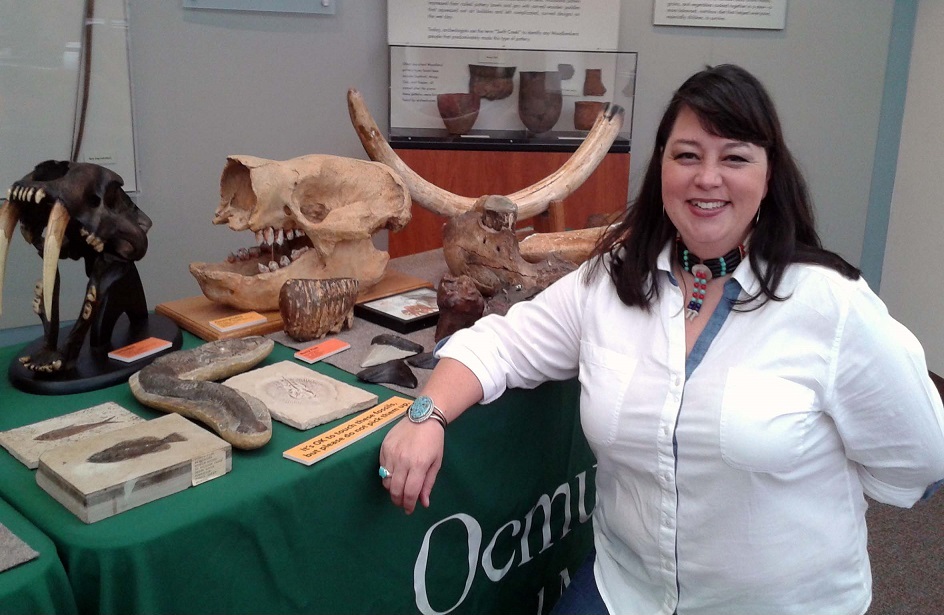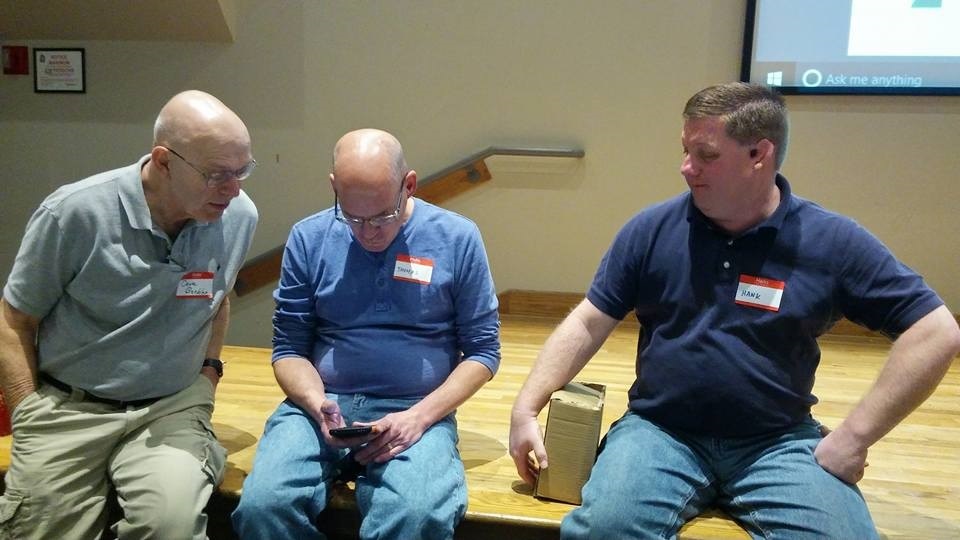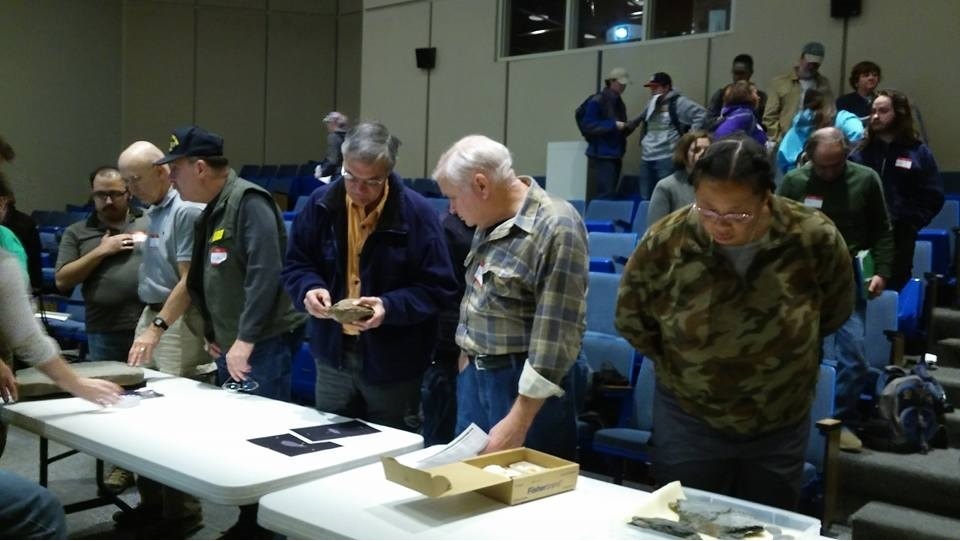by Thomas Thurman & Ashley Quinn
Thomas Thurman; GeorgiasFossils.com, Email: [email protected]; Ashley Quinn; Interim President, Paleontological Association of Georgia; Georgia College Natural History Museum; paleoga.weebly.com, Email: [email protected]
“A beginning is a very delicate time:” ~ The opening phrase from Dune, Frank Herbert, 1965.
On Saturday, January 28, 2017, over sixty Georgians gathered at the Macon Museum of Arts and Sciences with the intention of establishing a new Paleontological Association of Georgia. No such paleo group has existed in Georgia for decades.

The museum is centrally located in Georgia and its Director, Susan Welsh, freely offered the use of its auditorium. She has our gratitude. Ages from 8 to 80 attended the gathering. The crowd included a healthy dose of students, faculty, and staff from at least six universities, highly seasoned professional researchers, public school educators, and some of the most respected and experienced amateurs in the state. It’s off to a great start!
A lot of effort went into that first meeting, but it kicked off after Thomas Thurman and Ashley Quinn chatted at length one day about the possibility of establishing a new paleo association in Georgia based on the myFOSSIL, social paleontology, format.
Both of us recognized the need as many professionals, educators, and amateurs had lamented for years over the lack of such a group. Yet even through constant discussions over “we need a club!”, no one stepped forward to lead the effort. That changed with that conversation between Quinn and Thurman.
Thurman, an amateur, owns the website GeorgiasFossils.com which averages about 1,200 views and about 500 unique visitors per week. It’s a proud partner to the myFOSSIL Project. He’d set up “Georgia’s Fossils Group” on Facebook to support the website. He’d met Ashley, a professional, while assembling the site. She’s actually mentioned on the website several times.
After that fateful conversation, Ashley began researching bylaws and regulations. As the Collections Manager for the Georgia College Natural History Museum in Milledgeville, Georgia, Quinn is a solid vertebrate paleontologist in her own right. She has strong contacts in the research community and a good working knowledge of how a club is properly structured. Besides, Ashley is well liked.
Ashley and Thomas were both instrumental during the formation of this project. Ashley concentrated more on the aspects of structuring the enterprise. Thomas focused on permissions and contacting the sizable and growing list of other paleontology enthusiasts, amateurs, and professional contacts.
Thurman strongly believed that any paleontology society which hopes to bridge the gap between amateurs, educators, and professionals needs an established professional as its president. The obvious choice was Ashley and he asked if she’d be opposed to a nomination as Interim President. Leadership would be needed and it’d be months before any real structure could be established, with voting members, officers, dues, and committees. Her nomination was quickly seconded, and Ashley was voted in as our Interim President.

Collection Manager, Georgia College Natural History Museum
Georgia’s paleontology is rather unique; spanning over 500 million years from northwest Georgia’s Cambrian trilobites to the coastal plane Pleistocene mammoths, mastodons, and giant bison which once roamed throughout the state. Dinosaurs, pterosaurs, and giant crocodilians are found in west Georgia’s Cretaceous sediments. Mammal remains make their splash in central and east Georgia during the Eocene with brontotheres, entelodonts, Archaeocete whales, a mesonychid, and a Leptotragulus. South Georgia has a wealth of Oligocene through Pleistocene material.
Of course, each state has its unique attributes, but Georgia’s fossil record takes on the aspects of a Gordian Knot; it spans such a staggering range of geologic time and paleo-climates. Much of it still isn’t properly understood or mapped.
 Unfortunately, after a long decline in funding, the Georgia Geological Survey was abolished in 2004 after more than a century of solid research. Through the late 1970s, 1980s, and early 1990s the survey not only produced excellent research but also kept abreast of the commercial and academic work going on across the state. As a result, it acted as an informal networking service.
Unfortunately, after a long decline in funding, the Georgia Geological Survey was abolished in 2004 after more than a century of solid research. Through the late 1970s, 1980s, and early 1990s the survey not only produced excellent research but also kept abreast of the commercial and academic work going on across the state. As a result, it acted as an informal networking service.
When that essential network was broken, communication between institutions declined. This worsened over the years through competition for scant resources. The geography of the state, with rich northern and southern fossil beds separated by the fossil-barren Piedmont Plateau, tends to create specialists in local regions. This has led to natural history and science museums specializing in their region but often lacking basic knowledge over the rest of Georgia’s paleontology. Additionally, precious little of our state’s paleontological resources ever found their way into K-12 classrooms.
Assembling that essential network again (through a statewide association), and sustaining that network isn’t easy. Enthusiasm has to be kept high while the foundations of the club are established. The self-funded amateurs continue to explore and collect, while the professionals often have to spend their time grant writing, researching, and dealing with the needs of their occupations. Educators are typically swamped with their classroom duties and requirements; they address the needs of their students with a very limited budget.
Why is an alliance between amateurs and professionals needed? A few weeks before the meeting, a sportsman contacted Thurman through GeorgiasFossils.com and explained that he’d found “dinosaur” bones along a river in south central Georgia.
Thomas explained that the fossils couldn’t be dinosaur material since there were no age appropriate sediments that outcrop in that area. However, they could be anything from ancient whale to manatee, mammoth, or giant sloth. It depended on the age and type of the sediments. Thomas asked if pictures might be shared on Facebook’s Georgia’s Fossils Group. Professionals and knowledgeable amateurs reviewed the posts and advised the sportsman that these fossils were most likely ancient whale bones, probably the great whale Basilosaurus cetoides.
The Paleontological Association of Georgia (or PAG, although it does not have an official title yet) is a scientific, non-profit, community-based organization devoted to the study of Georgia’s natural history. The goal is not financial gain. PAG’s mission is to preserve Georgia’s paleontological resources for education, future research, and generations to come.
Responsible and legal fossil collecting is required in order to preserve the science of paleontology. PAG’s vision includes hosting club sponsored field trips and digs in the near future, but between then and now there is work to be done. Once the legalities are all in place, then attention can be focused on what makes paleontology associations fun, entertaining, rewarding, and educational.
That first meeting was splendid – so much knowledge under one roof, so many interesting conversations going on, so many cool fossils to ooh and aah over… and that was only the beginning… and “A beginning is a very delicate time.”

